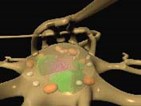Biochemical animations enhance pharm, bio research

Communicating the complexities of science
Three-dimensional imagery of today is advancing faster then anyone had imagined. We are able to scan the human body and produce a volumetric image showing possible tumors and health problems aiding in the fight against disease. However, one area of science that is not so easily scanned and imaged is biochemistry.
Biochemistry represents the bridge, or link, between anatomical imagery and chemical modeling. In recent years, advances in protein research and crystallography have enabled close study of macromolecular structure and function. Building on these advances, new visuals can be created to help researches determine how and why proteins function the way they do.
Biochemical Animations
Biochemical Animations (Creston, CA) is a scientific computer animating company dedicated to providing high-resolution computer animations for biotechnology and pharmaceutical research. Their goal is to help communicate the complexities of science by creating non-intimidating visual illustrations that retain high fidelity to the animated subject.
Biochemical Animations intends to fill the gap between still imagery and simple 2D animations. Current 3D imaging has focused well on anatomy, volumetric renditions, and simple protein visualization within standard web browsers. However, to date no one has animated the story of how these proteins work, what their importance is, and how they control the function of anatomical organs.
This is where Biochemical Animations comes in. The company's animations include precise renditions of molecular structures produced by high-end software and workstations to ensure the accuracy of the subject. These renderings illustrate a complicated topic by creating visuals that allow viewers' minds to relax and retain more information.

Animating presentations
One of the problems associated with communicating research at conferences is the audience can lose interest because too many topics are thrown at them at one time. Quorex Pharmaceuticals faced this challenge in May when they attended a pharmaceutical conference in London. Quorex had developed groundbreaking research regarding new antibiotic development but could only illustrate their advancement through a two dimensional PowerPoint slide presentation. Anyone who has put together a scientific presentation knows how difficult it is to compress background, research, and development using numerous busy illustrations that attempt to depict multiple processes, all while staying under their allotted timeframe.
Biochemical Animations was able to solve this problem for Quorex by animating, in less than a minute and a half, how bacterial pathogenesis works concerning newly discovered quorum sensing and how their technology stops infectious bacteria from attacking the tissue. Jeffrey Stein, VP and chief scientific officer for Quorex Pharmaceuticals, related the following: "The meeting in London went extremely well. I had the animation as the second-to-last [PowerPoint] slide and I could see everyone perk up when it started. I got the biggest response of any of the speakers in terms of questions and I attribute a big portion of that to the visuals."
Educational tools
Biochemical Animations also focuses on the classroom helping instructors visually communicate topics through computer animations that are otherwise difficult to illustrate by conventional multimedia. Science is very exciting, but it can be very difficult to communicate, especially to a non-scientific mind. Some topics are so technical even the best instructor winds up with a class full of confused students. Often students don't understand the lab procedure ahead of time and end up going through the motions as if they were following a recipe book for the first time. This mechanical experience robs them of the excitement of knowing the science behind the procedure
Animations have the potential to change negative science learning experiences into positive ones. Biochemical Animations presentations help students understand in minutes what may have taken hours to read and comprehend.
For more information: Jason Q. Baker, President and Executive Biochemical Animator, Biochemical Animations, 7091 Webster Rd., Creston, CA 93432. Tel: 805-238-4393. Email: jbaker@biochem3d.com.
